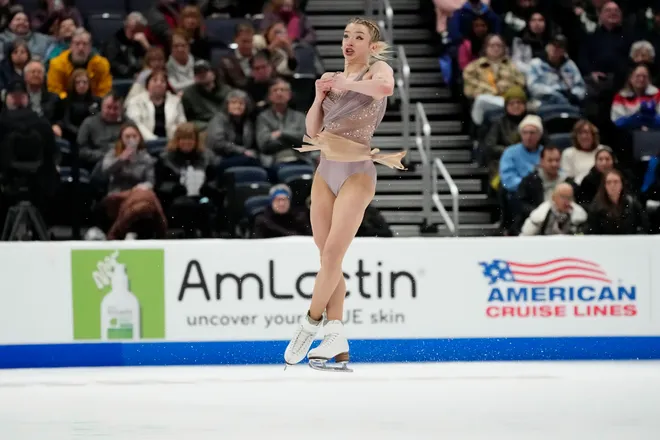U.S. women's figure skating at a crossroads amid Olympic medal drought of nearly 20 years
COLUMBUS — At the halfway mark of the Winter Olympic cycle, nearly two years after the 2022 Beijing Olympics and just a little more than two years before the 2026 Olympics in Italy, American women’s figure skating is at a troubling crossroads.
Can it somehow identify an athlete who can win the country’s first Olympic medal in women’s skating in 20 years? Or will it continue to miss the medal podium in one of the Olympics’ most prestigious events, watching other nations take home medals that once appeared to be an American birthright?
The U.S. drought in women’s Olympic figure skating is quite remarkable, something that few saw coming in the heady days right after the reign of Michelle Kwan, Tara Lipinski and Sarah Hughes. It’s both raw and real, the kind of sports streak that several generations of American athletes have tried, and failed, to stop.
The nation that has produced more Olympic women’s figure skating gold medalists than any other — including Tenley Albright, Carol Heiss Jenkins, Peggy Fleming, Dorothy Hamill and Kristi Yamaguchi — last won an Olympic medal of any color in women’s figure skating at the 2006 Olympics in Torino, Italy.
Heiss Jenkins said Friday that if someone had told her in 2006 that the United States would be shut out of women’s Olympic medals going on 20 years, she wouldn’t have believed it.

“I would have said you’re crazy,” she said in an interview. “I would have said there’s no way because we’ve always been very strong in women’s skating. I would have been very surprised.”
Since American Sasha Cohen won the silver medal at the 2006 Games, 12 Olympic medals have been handed out in women’s figure skating. Five have gone to Russians, including the last two gold and silver medals. Two each belong to South Korea, Japan and Canada. Italy accounts for the 12th.
What happened at the 2024 U.S. figure skating championships Friday night didn’t exactly instill confidence that Americans are about to right the ship.
Defending U.S. women’s champion Isabeau Levito, 16, experienced a dreadful meltdown, falling three times in her four-minute long program to drop to third place overall. Meanwhile, 24-year-old Amber Glenn won her first national women’s title, overcoming a couple of mistakes with a majestic triple axel to become the first openly LGBTQ+ athlete to win a U.S. women’s title.
“I do think that we are catching up for sure,” Glenn said when asked about the U.S. drought at the Olympics, “and as long as we keep trying to put out more consistent performances at major events, I think that we could see a brighter future for women’s figure skating in the U.S.”
Something that would certainly help U.S. medal prospects is for the Russians to not be allowed to compete in the 2026 Olympics in Milan. They will not be in Paris this summer as their war with Ukraine rages on. Where the world will be two years from now is anyone’s guess.
But Russia is always top of mind when thinking of Olympic women’s skating. Three-time national champion and 2014 Olympic team bronze medalist Ashley Wagner has spoken over the years about the “huge culture difference” between the United States and Russia. American parents, she said, might be reluctant to accept that their child “is going to give up their life at 5, 6, 7 for something we don’t know if it’s going to pay off or not.”
She said her long competitive career was due in part to not being “overloaded” with her sport, quite a contrast with the one-and-done Olympic careers of almost every Russian woman.
“When you are skating that intensely from such a young age, of course these girls are going to get burned out,” Wagner said.
“Russian skaters are essentially professionals,” Fleming said in a text message Friday night. “Ours are just athletes training with their own money.”
That individualized, patchwork approach is so quintessentially American, and very likely here to stay. In the U.S., skaters and coaches are scattered at rinks around the nation, the very antithesis of a Russian-style centralized system.
Another uniquely American development might also be affecting U.S. skating fortunes, Heiss Jenkins said. It’s Title IX, the 1972 law that opened the nation’s playing fields to girls and women, with spectacular results.
“There are a lot of options for team sports for these kids to go into,” she said. “Figure skating can be a very lonely sport. You’re out on the ice all by yourself. I think nowadays, the kids want to be around other teenagers and be on a team.”
Whatever the case, whatever the issue, this is a problem that isn’t going away in U.S. women’s skating. Much can happen in the next two years, but Glenn and/or Levito, or whoever represents the U.S. in Milan, will receive one question above all others: Are you the one who will end the drought?
Disclaimer: The copyright of this article belongs to the original author. Reposting this article is solely for the purpose of information dissemination and does not constitute any investment advice. If there is any infringement, please contact us immediately. We will make corrections or deletions as necessary. Thank you.







